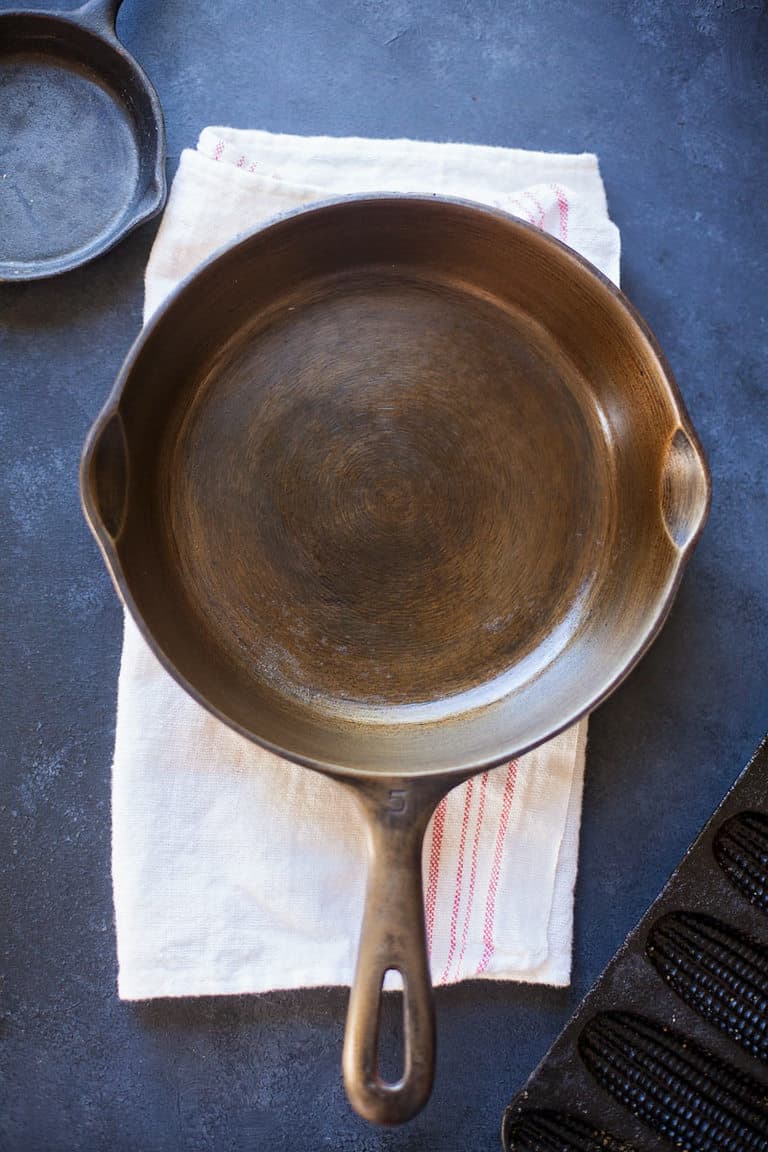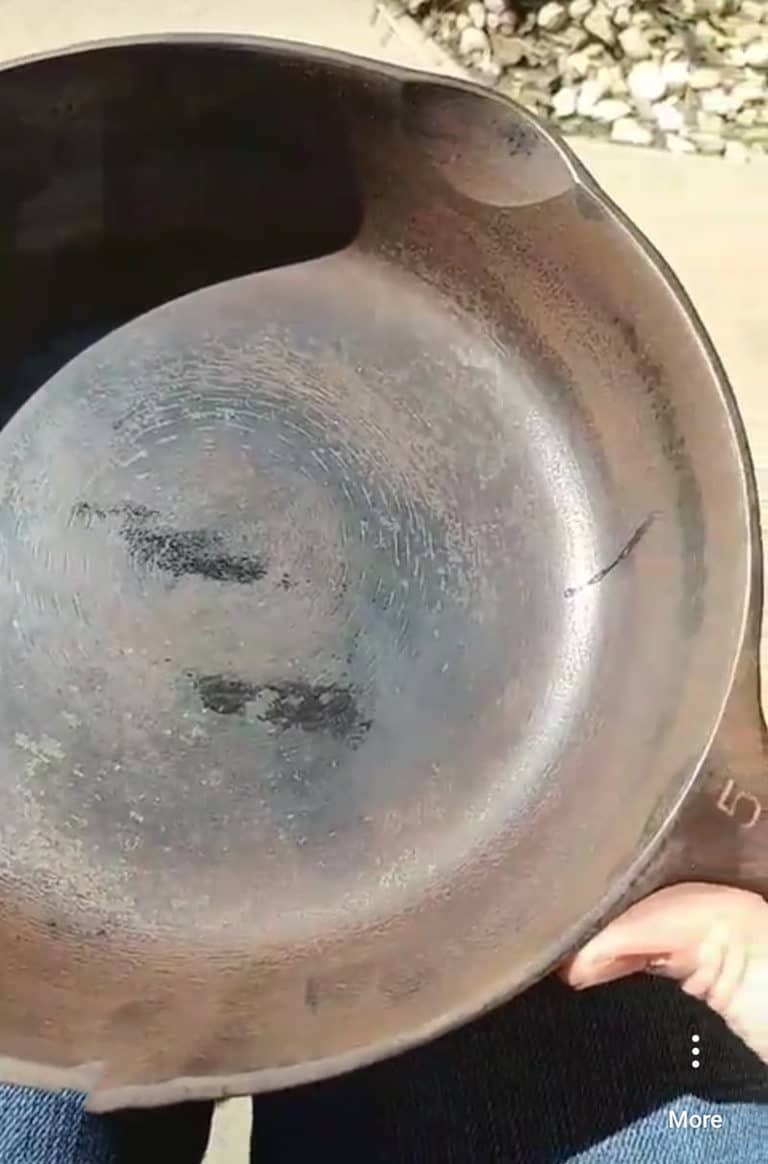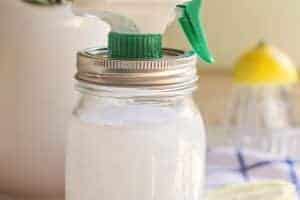How to clean a rusty cast iron skillet
Learn how to clean a rusty cast iron skillet and have it ready to use quickly and easily. It’s not nearly as hard as you might think!

I bought this skillet at an antique store for $15. And man, she was a beauty on the shelf. It looked perfect and I thought I had really gotten my hands on a great piece of cast iron.
All lies.
Because it turns out after I brought it home and rinsed it off (because I dare you to use random piece of cooking equipment from Lord knows where and not wash it first, even if you aren’t supposed to).
Well, as soon as water touched it, it revealed solid coating of rust. Which makes me think that the seller coated it lightly in some oil so you couldn’t see the rust. Sneaky sneaky.
But I was not beaten. Here’s how to clean a rusty cast iron skillet properly. (And sorry about the picture quality. I grabbed these shots from my Instagram stories after the project was finished.)

In order clean this rusty cast iron skillet, I was going to need to take it down below the rust level. Some people use steel wool for this, but I prefer sand paper.
What you’ll need to clean a rusty cast iron skillet
- 60 grit sandpaper
- Vegetable oil
- Paper towels
- Elbow grease
You’ll want to use a really tough sandpaper. I used 60-grit because I wanted to get off as much of that rust with every swipe as possible. Yes, it’s gonna scratch the surface of your skillet a bit, but it’s going to be fine. I went in circles, following the shape of the skillet inside the pan to help minimize any odd looking scratches.
And then you just get really dirty. Wear gloves if you’re one of those delicate folks with fancy nails. I’m not, so I just went after it. Scrub until you see shiny metal. How long that takes will depend on how deep the rust is and how much other gunk is on your rusty cast iron skillet.
For me, that took about 15 or 20 minutes to do the entire skillet. I focused on cleaning the inside where my food would touch more than the outside and I didn’t do the bottom of my skillet at all. The rust wasn’t nearly as bad there.

Once I had my rusty cast iron skillet this far, I was surprised to see how shiny it actually was. All the cast iron in my house is black from years of seasoning and use. It was pretty neat.
When you get all the rust out, go ahead and re-wash it with dish soap and water by hand. Never put your cast iron in a dishwasher. Then dry it out.
I gave mine a couple of minutes to air dry and I checked it for any spots of rust I might have missed that showed after it dried. We were all clear so it was time to season it.
How to season a cast iron skillet
Use a teaspoon of vegetable oil, and put it on a paper towel. Rub the oil over every surface–inside, outside, handles. Then place the skillet upside down on a piece of aluminum foil in your oven at 425 for an hour. You need the oven to be hot enough to get the oil to “bond” with the surface of the metal. Then turn the oven off and let the skillet sit in the oven to cool.
You may need to repeat the process two or three more times over the next few days until the surface is shiny but not sticky. If your skillet it sticky, you’ve used too much oil and not heated it high enough. If you can’t get the sticky out, you may have to scrub it back down and start over.
Once it’s seasoned you can use it as you would any other cast iron.
- Try to avoid washing it much after you get it seasoned–just wipe it out unless something is really stuck in it.
- And if you do need to wash it, try to scrub the stuck stuff with kosher salt and water only.
- If soap is required, you should rub it down with a dash of oil again to help protect the seasoning you worked so hard to get in there.
- Mine turned out a bit of a bronze color, but that’s fine. In time it will darken more.
If you are a beginner, check out my cast iron care guide for more details about how to clean a rusty cast iron skillet, seasoning tips and how to use your cast iron so it lasts forever.








I just got three rusty ones from some friends. I soaked them for an hour in vinegar first and it made the elbow grease portion of the task MUCH easier. I seasoned mine at a lower temperature, but wasn’t happy at the results. I think I’ll give yours a go. Thanks!
Oh good idea Brianna. You really do have to crank up the heat because you need the oil to change it’s molecular structure (so I read) and actually bond with the metal of your pan. That only happens at high temperatures. Otherwise your skillet may be sticky. Try it again and see how it goes! –Rachel
Thanks for this! I own 4 cast iron skillets I found in the woods several years ago. They are rusty, so I’ve never bothered with them even though I know they are valuable. Now I can fix them up for when I get a new stove!
Wow Nelly. I wish I could find cast iron skillets in the woods. I’m jealous. 😉 –Rachel